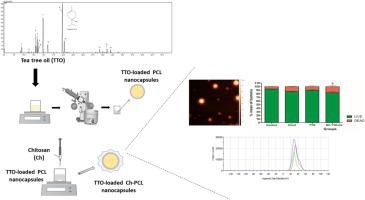Colloids and Surfaces B: Biointerfaces ( IF 5.8 ) Pub Date : 2020-09-19 , DOI: 10.1016/j.colsurfb.2020.111371 Natália Prado da Silva 1 , Eloá do Carmo Rapozo Lavinas Pereira 2 , Lucas Mattos Duarte 3 , Jhamine Caroline de Oliveira Freitas 4 , Camila Guimarães de Almeida 5 , Thiago Pereira da Silva 6 , Rossana C N Melo 6 , Ana Carolina Morais Apolônio 7 , Marcone Augusto Leal de Oliveira 8 , Humberto de Mello Brandão 5 , Frederico Pittella 2 , Rodrigo Luiz Fabri 9 , Guilherme Diniz Tavares 2 , Priscila de Faria Pinto 10

|
The purpose of this study was to develop tea tree oil (TTO)-loaded chitosan-poly(ε-caprolactone) core-shell nanocapsules (NC-TTO-Ch) aiming the topical acne treatment. TTO was analyzed by gas chromatography-mass spectrometry, and nanocapsules were characterized regarding mean particle size (Z-average), polydispersity index (PdI), zeta potential (ZP), pH, entrapment efficiency (EE), morphology by Atomic Force Microscopy (AFM), and anti-Cutibacterium acnes activity. The main constituents of TTO were terpinen-4-ol (37.11 %), γ-terpinene (16.32 %), α-terpinene (8.19 %), ρ-cimene (6.56 %), and α-terpineol (6.07 %). NC-TTO-Ch presented Z-average of 268.0 ± 3.8 nm and monodisperse size distribution (PdI < 0.3). After coating the nanocapsules with chitosan, we observed an inversion in ZP to a positive value (+31.0 ± 1.8 mV). This finding may indicate the presence of chitosan on the nanocapsules' surface, which was corroborated by the AFM images. In addition, NC-TTO-Ch showed a slightly acidic pH (∼5.0), compatible with topical application. The EE, based on Terpinen-4-ol concentration, was approximately 95 %. This data suggests the nanocapsules' ability to reduce the TTO volatilization. Furthermore, NC-TTO-Ch showed significant anti-C. acnes activity, with a 4× reduction in the minimum inhibitory concentration, compared to TTO and a decrease in C. acnes cell viability, with an increase in the percentage of dead cells (17 %) compared to growth control (6.6 %) and TTO (9.7 %). Therefore, chitosan-poly(ε-caprolactone) core-shell nanocapsules are a promising tool for TTO delivery, aiming at the activity against C. acnes for the topical acne treatment.
中文翻译:

茶树油负载壳聚糖-聚(ε-己内酯)核壳纳米胶囊的抗痤疮杆菌痤疮活性提高
这项研究的目的是开发针对局部痤疮治疗的茶树油(TTO)负载的壳聚糖-聚(ε-己内酯)核壳纳米胶囊(NC-TTO-Ch)。通过气相色谱-质谱法分析TTO,并对纳米胶囊的平均粒径(Z-平均值),多分散指数(PdI),ζ电位(ZP),pH,包封效率(EE),形态进行原子力显微镜表征( AFM)和抗痤疮杆菌的活性。TTO的主要成分是萜品烯-4-醇(37.11%),γ-萜品烯(16.32%),α-萜品烯(8.19%),ρ-甲烯(6.56%)和α-松油醇(6.07%)。NC-TTO-Ch的Z均值为268.0±3.8 nm,单分散尺寸分布(PdI <0.3)。用壳聚糖包被纳米胶囊后,我们观察到ZP转化为正值(+31.0±1.8 mV)。这一发现可能表明壳聚糖在纳米胶囊的表面上存在,这被AFM图像证实。此外,NC-TTO-Ch的pH呈弱酸性(〜5.0),与局部应用相容。基于萜品四醇的浓度,EE约为95%。该数据表明纳米胶囊具有减少TTO挥发的能力。此外,与TTO相比,NC-TTO-Ch具有显着的抗痤疮丙酸杆菌活性,最小抑制浓度降低了4倍,痤疮丙酸杆菌减少细胞存活率,与生长对照(6.6%)和TTO(9.7%)相比,死细胞百分比(17%)增加。因此,壳聚糖聚(ε-己内酯)核壳纳米胶囊是一种有前途的TTO传递工具,旨在针对痤疮丙酸杆菌的局部痤疮治疗活性。



























 京公网安备 11010802027423号
京公网安备 11010802027423号